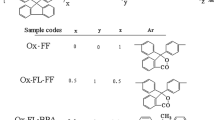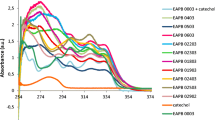Abstract
Room temperature electronic absorption and fluorescence spectra of harmol, harmalol and 2-hydroxycarbazole have been obtained in concentrated aqueous potassium hydroxide solutions. The appearance of a new fluorescence band for all these compounds in media of H_ greater than 16, has been ascribed to the emission of excited dianions formed by deprotonation. Acidity constants have been estimated from the Föster-Weller method.
Similar content being viewed by others
References
Szantay C, Blaskö G, Honty H, Dörnyei D. The alkaloids. Vol. 27. New York: Academic Press, 1986.
Schilitter E, Bein HJ. Medicinal chemistry. Vol. 7. New York: Academic Press, 1967.
Müller WE, Fehske KJ, Borbe HO, Wollert U, Nanz C, Rommelspacher H. On the neuropharmacology of harmane and other beta-carbolines. Pharmacol Biochem Behav 1981;14:693–9.
Bloom F, Barchas J, Sandler M, Usdin E. Betacarbolines and tetrahydroisoquinolines. New York: Alan R. Liss, 1982.
Beljanski M, Beljanski MS. Selective inhibition ofin vitro synthesis of cancer DNA by alkaloids of betacarboline class. Exp Cell Biol 1982;50:79–87.
Beljanski M, Beljanski MS. Three alkaloids as selective destroyers of the proliferative capacity of cancer cells. IRCS Med Sci 1984;12:587–8.
Hadley SG, Muraki AS, Spitzer K. The fluorescence and phosphorescence spectra and phosphorescence decay time of harmine, harmaline, harmalol, harmane, and norharman in aqueous solutions and EPA at 77 K. J Forensic Sci 1974; 19:657–69.
Denckla WD, Dewey HK. The determination of tryptophan in plasma, liver, and urine. J Lab Clin Med 1967;69(1):160–9.
Sakurovs R, Ghiggino KP. Excited state proton transfer in beta-carboline. J Photochem 1982;18:1–8.
Wolfbeis OS, Fürlinger E, Wintersteiger R. Solvent and pH-dependence of the absorption and fluorescence spectra of harman: detection of three ground state and four excited state species. Monatsschr Chem 1982;113:509–13.
Wolfbeis OS, Fürlinger E. The pH-dependence of the absorption and fluorescence spectra of harmine and harmol: drastic differences in the tautomeric equilibria of ground and first excited singlet state. Z Phys Chem NF 1982;129:171–83.
Tomás Vert F, Zabala Sánchez I, Olba Torrent A. Acidity constants of beta-carbolines in the ground and excited singlet states. J Photochem 1983;23:355–68.
Tomás Vert F, Zabala Sánchez I, Olba Torrent A. Acidity constants of harmaline and harmalol in the ground and excited singlet states. J Photochem 1984;26:285–94.
Savory B, Turnbull JH. Luminescence spectra of harmine, harmaline, reserpiline and 3-dehydroreserpines. J Photochem 1984;24:355–71.
Tomás F, Zabala I, Olba A. Acid-base and tautomeric equilibria of harmol in the ground and first excited singlet states. J Photochem 1985;31:253–63.
Olba Torrent A, Tomás Vert F, Zabala Sánchez I, Medina Casamayor P. Fluorescence, phosphorescence and basicity in the first excited triplet of 2-methyl-harmine and harmaline. J Photochem 1987;37:109–16.
Balón M, Muñoz MA, Hidalgo J, Carmona MC, Sánchez M. Fluorescence characteristics of beta-carboline alkaloids in highly concentrated hydroxide solutions. Photochem 1987;36:193–204.
Muñoz Perez MA, Carmona Guzmán MC, Hidalgo Toledo J, Balón Almeida M. Ionization of betacarbolines in concentrated hydroxide solutions. J Chem Soc Perkin Trans II 1986:1573–5.
Douglas KT, Sharma RK, Walmsley JF, Hider RC. Ionization processes of some harmala alkaloids. Mol Pharmacol 1983;23:614–8.
Yagil G. The effect of ionic hydration on equilibria and rates in concentrated electrolyte solutions. III. The H_ scale in concentrated hydroxide solutions. J Phys Chem 1967;71:1034–44.
Balón-Almeida M, Muñoz-Perez MA, Carmona-Guzmán MC, Hidalgo-Toledo J. Ionization equilibria of harmol and harmalol in concentrated hydroxide solutions. J Chem Soc Perkin Trans II 1988:1165–7.
Cox RA, Stewart R. The ionization of feeble organic acids in DMSO-water mixtures. Acidity constants derived by extrapolation to the aqueous state. J Am Chem Soc 1976;98:488–94.
Donckt EV. Acid-base properties of excited states. Prog React Kinet 1970;5:273–99.
Yagil G. The proton dissociation constant of pyrrole, indole and related compounds. Tetrahedron 1967;23:2855–61.
Capomacchia AC, Schulman SG. Protolysis of five-membered heterocycles in the lowest excited singlet state: carbazole andN-ethylearbazole. Anal Chim Acta 1972;59:471–3.
Samanta A, Chattopadhyay N, Nath D, Kundu T, Chowdhury M. Excited-state proton transfer kinetics of carbazole. Chem Phys Lett 1985;121:507–12.
Balón M, Carmona MC, Muñoz MA, Hidalgo J. The acid-base properties of pyrrole and its benzologs indole and carbazole. A reexamination from the excess acidity method. Tetrahedron 1989;45:7501–4.
Author information
Authors and Affiliations
Rights and permissions
About this article
Cite this article
Hidalgo, J., Carmona, C., Balón, M. et al. Fluorescence of harmol, harmalol and 2-hydroxycarbazole in concentrated hydroxide solutions. Pharmaceutisch Weekblad Scientific Edition 12, 142–144 (1990). https://doi.org/10.1007/BF01970154
Accepted:
Issue Date:
DOI: https://doi.org/10.1007/BF01970154




